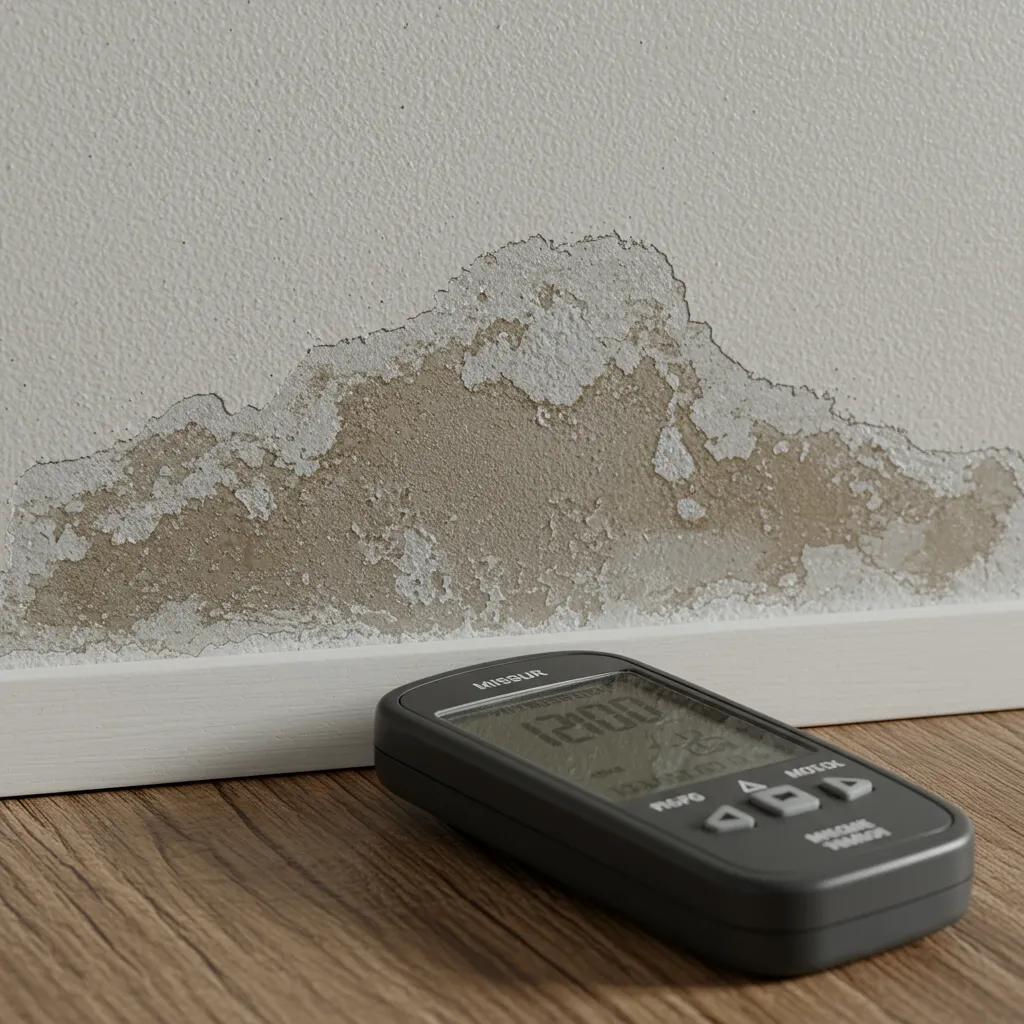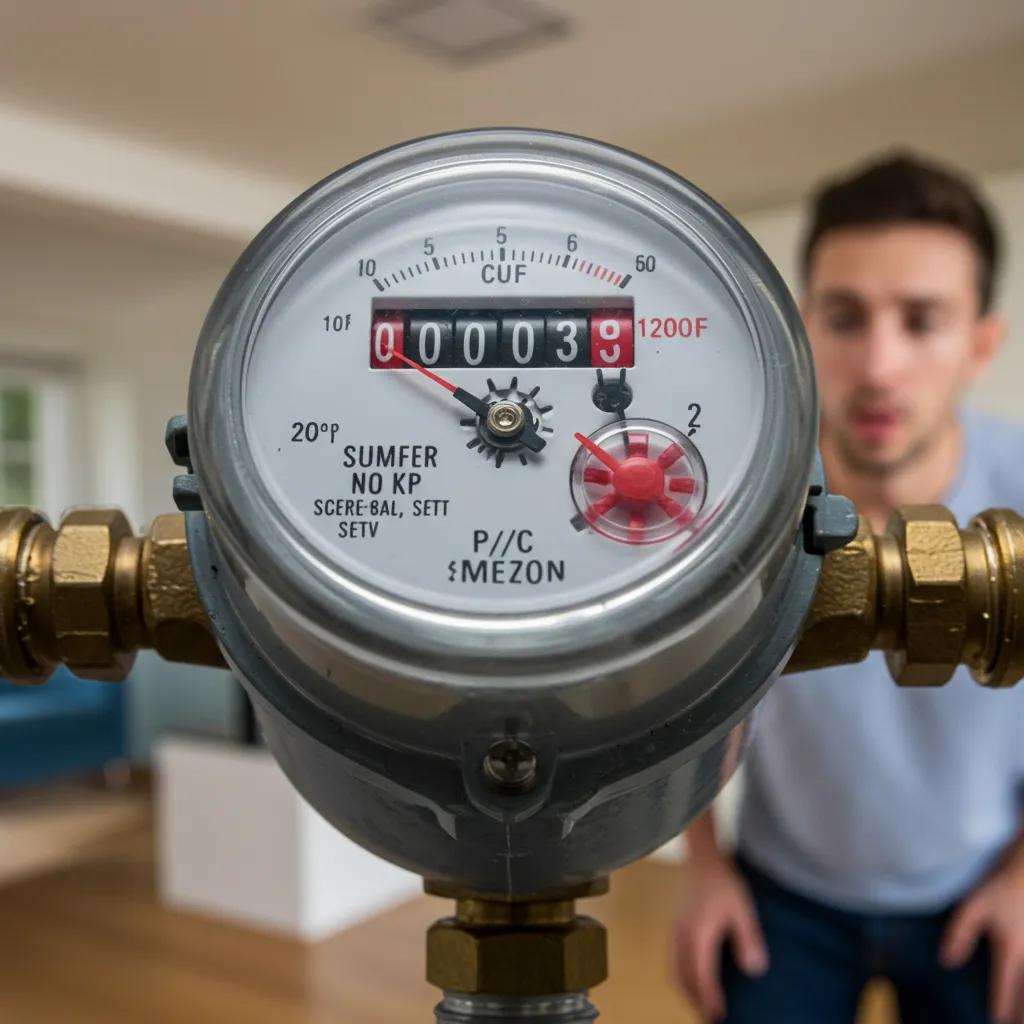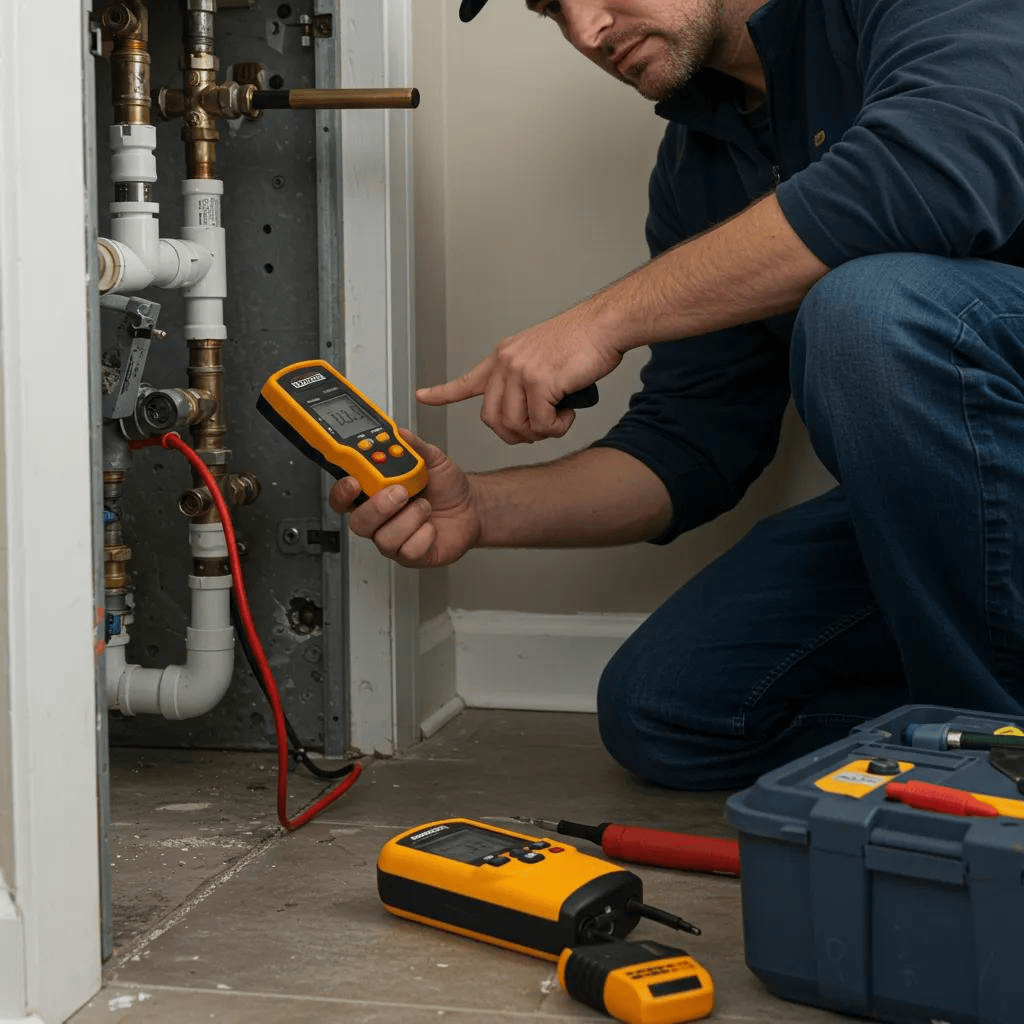Spotting Hidden Leaks: Your Guide to Finding, Diagnosing, and Fixing Water Issues
Unseen water leaks lurk behind walls, beneath floors, and under landscaping, silently damaging your property and inflating your utility bills if not caught quickly. This guide will walk you through identifying common signs of these hidden problems, understanding how diagnostic methods work, and implementing effective repair and prevention strategies for both homes and businesses. You'll learn practical checks you can do yourself, the science behind acoustic, thermal, and tracer gas detection, and when a video camera inspection is the best next step. The core issue is simple: small, hidden leaks lead to big problems. Our solution is a systematic approach to detection, diagnosis, and repair that minimizes water damage and restores your plumbing system's integrity. This article covers key areas: recognizing hidden leak indicators, the most effective detection methods, types of plumbing leaks and their associated risks, emergency response triggers, commercial property considerations, and preventative maintenance. Throughout, we'll reference local services from Seacoast Sewer & Drain, Inc. and advise on when to seek urgent or expert assistance.
After reading, if you suspect an active leak, reach out to Seacoast Sewer & Drain, Inc. for rapid, 24/7 response and diagnostics using Video Camera Inspection and Pipe Locating & Repair. Their emergency team serves Southern Maine and Seacoast New Hampshire and can be contacted at (207) 464-9003.
What Are the Common Signs of Hidden Water Leaks?
A hidden water leak is revealed by noticeable changes or measurable increases that indicate water escaping the plumbing system where it shouldn't, leading to dampness, higher water usage, and pressure fluctuations that can harm your property. These signs are effective because escaping water alters humidity levels, leaves thermal or acoustic traces, and registers on your water meter. Catching them early simplifies repairs and prevents mold growth. Identifying these symptoms allows for targeted professional diagnostics, helping homeowners prioritize necessary services. Below, we list the most reliable indicators for homes and businesses and explain how to verify them.
Homeowners and property managers should treat persistent, unexplained signs as a signal to investigate. The next section explains why damp spots and musty odors are early warnings and how they connect to structural risks.
Damp patches and musty smells signal trapped moisture and a potential for mold growth in hidden areas.
How Do Damp Patches and Musty Smells Indicate a Leak?

Damp patches appear as discolored areas on walls, baseboards, or ceilings because escaping water saturates building materials and carries minerals that stain finishes. Musty odors develop when trapped moisture encourages microbial growth. This process is significant because mold and rot can spread rapidly once humidity levels rise, potentially causing health issues and structural damage. Early detection is key to limiting this spread.
A simple check for homeowners is to press a white tissue against suspicious areas to see if it picks up moisture. Also, inspect nearby floor cavities and baseboards for softness. Using a moisture meter can provide objective confirmation. Recognizing these visual and olfactory clues leads directly to targeted diagnostics like thermal imaging or video inspection, which we'll discuss next.
Which Water Leak Detection Methods Are Most Effective?
Effective leak detection relies on non-invasive technologies that capture the leak's signature—whether it's sound, temperature, tracer gas escape, or visual evidence inside the pipe. Each method offers unique advantages for specific types of leaks. Acoustic leak detection listens for the sound of escaping water, thermal imaging visualizes temperature differences caused by moisture, tracer gas helps locate leaks under concrete, video camera inspection provides direct visual confirmation inside pipes, and water meter tests establish baseline consumption. Choosing the right method minimizes excavation and repair time while maximizing diagnostic accuracy. Often, combining approaches yields the best results.
The table below summarizes how these methods perform and when they are most suitable.
This table clarifies the selection process: start with non-invasive scans and move to tracer gas or localized excavation as needed. In summary, combining acoustic/thermal screening with video camera inspection is ideal for most concealed leak investigations, balancing speed and certainty.
Now, we'll explain each method in practical terms and why Seacoast Sewer & Drain, Inc. recommends specific tools for common scenarios.
How Does Acoustic Leak Detection Work to Find Pipe Leaks?
Acoustic leak detection transforms the vibrations caused by escaping water into audible and visual signals using ground microphones and pipe sensors. Analysts correlate the timing and amplitude of these signals to estimate the leak's location. The principle is based on detecting sound energy transmitted through the pipe material and surrounding ground; quieter leaks or noisy environments can reduce clarity. Acoustic tools are highly effective for pressurized water mains and service lines and are particularly useful before any digging begins, preventing unnecessary disruption. If acoustic results are unclear, technicians often employ complementary methods like thermal imaging or Video Camera Inspection.
Research confirms that acoustic leak detection is a primary method for identifying leaks in pressurized lines, offering a non-invasive approach to pinpointing issues.
Active Acoustic Leak Detection in Pressurised PVC Pipes
This paper proposes an active method using an acoustic source to excite a pressurized PVC pipe, generating acoustic waves that travel along it. A leak creates a disturbance in these waves, detectable by sensors placed along the pipe. Validation through experimental tests showed the method accurately detects and locates leaks in pressurized PVC pipes. Active acoustic leak detection in a pressurized PVC pipe, MD Kafle, 2020
Additionally, studies have explored the effectiveness of in-pipe acoustic measurements, demonstrating their value in pinpointing leaks within water pipelines.
Acoustic Leak Detection in Water Pipelines Using In-Pipe Measurements
This study presents an experimental investigation of acoustic measurements taken inside a water pipeline for leak detection. An experimental setup simulated a water pipeline with artificial leaks. Acoustic signals were recorded internally using hydrophones, and analysis identified characteristics specific to leak-generated signals. Results confirm that in-pipe acoustic measurements effectively detect and locate leaks in water pipelines. Acoustic detection of leaks in water pipelines using measurements inside pipe, YA Khulief, 2012
What Are the Benefits of Thermal Imaging for Leak Detection?
Thermal imaging detects temperature differences where moisture cools surfaces, creating a visual pattern that highlights wet areas without needing to cut into walls or excavate. The primary advantage is speed: a skilled operator can scan large areas quickly, helping to prioritize where more detailed diagnostics are needed, thereby reducing guesswork and unnecessary repairs. Thermal cameras can sometimes produce misleading readings due to direct sunlight or nearby heat sources, so interpretation requires expertise and often verification with moisture meters. When used alongside acoustic detection and video inspection, thermal imaging helps narrow down the search area for precise, minimally invasive location.
How Can Water Meter Tests Help Detect Undiscovered Leaks?

A water meter test involves comparing static readings over a period when no water is being used. Persistent movement indicates an active flow path and a probable leak, serving as a low-cost initial screening step. This method leverages the meter's sensitivity to small flows, providing a quantitative basis for deciding whether professional detection services are necessary. Homeowners can perform this test by recording the meter reading, ensuring no water is used, and checking again after a set interval. Any change suggests active leakage. When the test confirms a leak, the next step is to use pipe locating for precise localization and repair planning.
What Are the Different Types of Plumbing Leaks and Their Risks?
Plumbing leaks vary in location and cause, each presenting distinct signs and requiring specific repair strategies. Classifying the leak helps prioritize the response and select the most effective diagnostic tools. Common categories include slab leaks (under concrete foundations), pipe joint and faucet leaks (at connections), toilet and water heater leaks (fixture-related), and drain leaks or burst pipes (which may require emergency action). Understanding the immediate risks associated with each type—structural harm, mold, contamination, or service interruption—guides whether a homeowner can implement a temporary fix or needs to call professionals for repair.
What Defines a Slab Leak and How Is It Detected?
A slab leak occurs when a pressurized pipe beneath a concrete foundation cracks or corrodes, allowing water to seep under flooring and into structural components. Detection is challenging because the leak is hidden from view. Detection methods rely on acoustic technology, tracer gas, and thermal imaging to narrow down the leak's path before any cutting is performed, thereby reducing the scope and cost of excavation. Signs include localized warm spots on the floor, consistently high water bills, and surface dampness without any visible plumbing issues. Because slab leaks can compromise foundations and flooring, prompt professional location and repair are essential.
How Do Pipe Joint and Faucet Leaks Differ in Symptoms and Repair?
Faucet leaks are typically visible at the fixture itself and usually stem from worn seals or cartridges. They manifest as dripping taps or pooling water and are often repairable by homeowners. Pipe joint leaks, however, are concealed at connection points and present indirect symptoms like staining or pressure loss. The difference in mechanism is significant: faucet faults are surface-level repairs, while joint leaks may necessitate opening walls or ceilings and using diagnostic imaging to find the failure. Quick checks include isolating the fixture and monitoring the water meter. Persistent hidden joint leaks require professional diagnostics like acoustic detection or Video Camera Inspection. Repair approaches range from replacing seals to cutting and rejoining pipe sections, depending on accessibility and severity.
What Are the Signs of Toilet and Water Heater Leaks?
Toilet leaks often appear as a continuously running tank, water pooling around the base, or unexplained refilling cycles. Water heater leaks typically produce puddles near the tank, rust-colored stains, or a sudden decrease in hot water availability. These symptoms arise because valves, seals, and tanks degrade over time, allowing water to bypass controls or escape from weakened materials. Homeowners can check the flapper and fill valve operation for toilets and inspect visible fittings on water heaters, but tank leaks usually necessitate appliance replacement. When these signs appear, schedule prompt service to prevent floor damage and potential appliance failure.
How Can Drain Leaks and Burst Pipes Cause Emergency Situations?
Drain leaks that result in sewer backup or burst pipes that release large volumes of water create immediate hazards, including contamination, flooding, and electrical risks. These situations can rapidly escalate from a nuisance to a property-wide emergency. The mechanism is straightforward: uncontrolled discharge overwhelms drainage systems and can saturate structural elements within hours, leading to mold growth, damage to finishes, and risks to occupants. Immediate homeowner actions include shutting off the main water supply and, if safe, isolating electrical circuits in the affected area, followed by contacting emergency plumbing services. Professional response involves rapid Pipe Locating & Repair, temporary containment measures, and subsequent permanent restoration.
Frequently Asked Questions
What preventative measures can I take to avoid future leaks?
To prevent future leaks, regular maintenance is key. This includes inspecting visible pipes and connections for signs of wear, testing water pressure to ensure it remains within safe limits, and replacing old or damaged fixtures. Additionally, consider scheduling annual professional inspections that include thermal and acoustic scans to detect hidden issues before they escalate. Implementing these proactive measures can significantly reduce the risk of leaks and associated repair costs, ensuring the longevity of your plumbing system.
How can I tell if my water heater is leaking?
Signs of a leaking water heater include puddles or moisture around the base, rust on the tank, and a sudden drop in hot water supply. You may also notice unusual noises, such as popping or rumbling, which can indicate sediment buildup or internal damage. Regularly inspecting the fittings and connections for signs of wear can help catch leaks early. If you suspect a leak, it’s advisable to contact a professional for a thorough inspection and necessary repairs to prevent further damage.
What should I do if I find a leak in my home?
If you discover a leak, the first step is to shut off the water supply to prevent further damage. Document the leak with photos and note any visible signs, such as damp patches or water pooling. Next, perform a water meter test to confirm the leak's presence. Avoid attempting extensive repairs yourself, as this can lead to further complications. Instead, contact a qualified leak detection service to accurately locate and repair the issue, ensuring minimal disruption to your home.
How often should I schedule professional leak detection services?
It is recommended to schedule professional leak detection services at least once a year, especially for older properties or those with a history of plumbing issues. Additionally, consider scheduling inspections after significant renovations, during seasonal changes, or if you notice unusual spikes in your water bill. Regular inspections help identify hidden leaks early, allowing for timely repairs and reducing the risk of extensive damage and costly repairs in the future.
Conclusion
Identifying and addressing hidden water leaks is crucial for protecting your property and minimizing costly damage. By utilizing effective detection methods and understanding the signs of leaks, homeowners can take proactive steps to maintain their plumbing systems. For immediate assistance, consider reaching out to Seacoast Sewer & Drain, Inc. to ensure your home remains safe and leak-free. Explore our resources for more tips on leak prevention and maintenance today.
Recent Blog Post
Customer Reviews




























